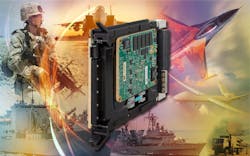The official Sensor Open Systems Architecture (SOSA) standard is out; so now what?
THE MIL & AERO COMMENTARY. One of the most influential open-systems standards for embedded computing designs in years has been released in its first official version, so now we're about to find out how important the Sensor Open Systems Architecture (SOSA) standard will be in the long term.
We've been hearing about SOSA at least for the past seven years. The standard seeks to help create a level playing field for embedded computing suppliers and systems integrators who serve the aerospace and defense market. At the very least, SOSA promises to tame the beast of thinly cloaked proprietary architectures that collectively have become known as OpenVPX. At best, SOSA may help military systems designers achieve their dream of high-performance embedded computing at affordable prices.
So SOSA is seven years in, and there's still quite a ways to go before this standard becomes a familiar part of the landscape. SOSA seeks to benefit embedded systems suppliers by incorporating existing standards like OpenVPX as much as possible. The idea is to avoid re-inventing what's already known, and to a great degree SOSA appears to be heading in that direction.
At the same time, however, SOSA is generating no lack of confusion and controversy. The framers of SOSA have been prickly about terminology. Is it compliant? Is it conformant? No, it's aligned; many of us have run afoul of the required terms.
Until the end of last September, there was no official SOSA standard; all of its evolving iterations were called snapshots. Those who tried to meet SOSA guidelines had to do their best to meet the spirit of these snapshots, yet the standard had no binding authority. Since there was no official standard, no products could be called SOSA-compliant or SOSA-conformant. Instead, industry adopted the term "SOSA-aligned."
Now that there's an official standard, however, industry still can't claim to be compliant or conformant to SOSA. Today's there's no way to prove compliance, and it will be about eight months to a year before compliance testing will be in place to ensure that products meet the SOSA specifications. Only then -- sometime in 2022 if we're lucky -- will companies be able to put a SOSA-conformant or SOSA-compliant sticker on their products.
Adding to this uncertainty, the SOSA market has yet to define itself clearly, which leaves some embedded computing suppliers wondering if the standard applies to them. The way it's shaking out, SOSA will apply directly to bus-and-board designs, as it goes into detail on standardizing backplanes, connectors, power, I/O interfaces, and form factors.
But what about embedded computing suppliers who specialize in rugged servers built largely on proprietary technology, and who make no claim about industry-standard designs inside the enclosures? Can they play in the SOSA market? As of right now it's not clear. The answer probably is not now, but perhaps in the future. It's likely that the SOSA committees who work under aegis of The Open Group in San Francisco eventually will define standard box-to-box interfaces as part of the SOSA standard. That's in the future, though.
Moreover, what about high-performance embedded computing suppliers who specialize in the latest technologies and who don't particularly care about meeting industry standards? Some of these would argue that SOSA is trying to solve design problems that persisted 10 or 15 years ago in bus-and-board designs that had to consider future upgrades and technology insertion.
Today that may no longer be the case, they argue. Today designers typically upgrade systems by pulling out old boxes and replacing them with new ones. If that's the case, then who cares what's inside the box, as long as it can interoperate efficiently with other components in the system?
These are some of the issues that SOSA will have to confront as the new standard evolves to meet aerospace and defense needs of the future. If it doesn't, then SOSA could be the latest design approach to be tossed on the scrap heap of history.
About the Author
John Keller
Editor-in-Chief
John Keller is the Editor-in-Chief, Military & Aerospace Electronics Magazine--provides extensive coverage and analysis of enabling electronics and optoelectronic technologies in military, space and commercial aviation applications. John has been a member of the Military & Aerospace Electronics staff since 1989 and chief editor since 1995.
